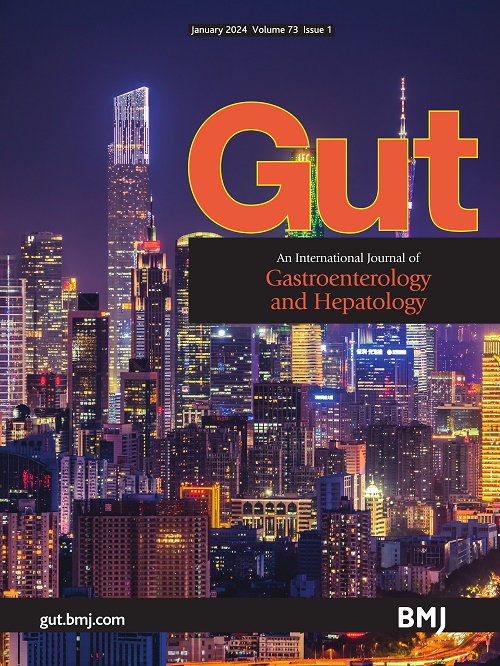CNNM4:胆管癌中的铁致下垂易感性
IF 25.8
1区 医学
Q1 GASTROENTEROLOGY & HEPATOLOGY
引用次数: 0
摘要
胆管癌(CCA)是影响胆道树的最具侵袭性的恶性肿瘤之一,治疗选择有限,死亡率高。尽管分子肿瘤学最近取得了进展,但CCA的预后仍然很差,迫切需要新的治疗策略。在此背景下,Mercado-Gomez等人发表的研究1对CNNM4(一种镁转运蛋白)在CCA中作为铁凋亡调节因子的作用提供了重要的见解。通过展示CNNM4如何影响镁稳态、氧化应激和癌症代谢,本研究为探索旨在调节铁下垂的靶向治疗作为抗癌方法奠定了基础(图1)。图1在胆管癌(CCA)中靶向CNNM4诱导铁下垂并降低肿瘤侵袭性。该示意图说明了通过siRNA抑制CNNM4如何重塑CCA生物学,将肿瘤细胞从增殖和耐药状态转变为更容易受到细胞死亡影响的状态。在左侧,CCA细胞表现出高CNNM4表达,主动将镁(Mg²+)运输出细胞,这一过程支持肿瘤存活、代谢适应和治疗抵抗。在sirna介导的CNNM4沉默(中)中,这种平衡被破坏,导致细胞内铁(Fe)积累并触发铁凋亡,这是一种铁依赖性的程序性细胞死亡形式,CCA细胞通常会逃避。在右边,CNNM4抑制导致肿瘤行为的深刻转变-减少耐药性,改变代谢途径,降低癌症干细胞特性并最终抑制转移。在底部,表明了镁积累和诱导铁下垂的机制。这些发现突出了CNNM4作为一个有希望的治疗靶点,其抑制作用不仅促进铁下垂,而且还削弱CCA最具侵略性的性状,为治疗开辟了新的途径。ROS,活性氧。镁是……本文章由计算机程序翻译,如有差异,请以英文原文为准。
CNNM4: a ferroptotic vulnerability in cholangiocarcinoma
Cholangiocarcinoma (CCA) represents one of the most aggressive malignancies affecting the biliary tree, with limited treatment options and high mortality rates. Despite recent advances in molecular oncology, the prognosis for CCA remains poor, highlighting the urgent need for novel therapeutic strategies. In this context, the study published by Mercado-Gomez et al ,1 provides significant insights into the role of CNNM4, a magnesium transporter, as a regulator of ferroptosis in CCA. By demonstrating how CNNM4 influences magnesium homoeostasis, oxidative stress and cancer metabolism, this study lays the groundwork for exploring targeted therapies aimed at modulating ferroptosis as an anticancer approach (figure 1). Figure 1 Targeting CNNM4 to induce ferroptosis and reduce tumour aggressiveness in cholangiocarcinoma (CCA). This schematic illustrates how CNNM4 inhibition via siRNA reshapes CCA biology, shifting tumour cells from a proliferative and resistant state to one that is more vulnerable to cell death. On the left, CCA cells exhibit high CNNM4 expression, actively transporting magnesium (Mg²+) out of the cell, a process that supports tumour survival, metabolic adaptation and therapy resistance. On siRNA-mediated CNNM4 silencing (centre), this balance is disrupted, leading to intracellular iron (Fe) accumulation and triggering ferroptosis, an iron-dependent form of programmed cell death that CCA cells normally evade. On the right, CNNM4 inhibition results in a profound shift in tumour behaviour—reducing drug resistance, altering metabolic pathways, decreasing cancer stem cell properties and ultimately suppressing metastasis. On the bottom, the mechanisms that link magnesium accumulation and induction of ferroptosis are indicated. These findings highlight CNNM4 as a promising therapeutic target, where its inhibition not only promotes ferroptosis but also weakens CCA’s most aggressive traits, opening new avenues for treatment (Created with BioRender). ROS, reactive oxygen species. Magnesium is …
求助全文
通过发布文献求助,成功后即可免费获取论文全文。
去求助
来源期刊

Gut
医学-胃肠肝病学
CiteScore
45.70
自引率
2.40%
发文量
284
审稿时长
1.5 months
期刊介绍:
Gut is a renowned international journal specializing in gastroenterology and hepatology, known for its high-quality clinical research covering the alimentary tract, liver, biliary tree, and pancreas. It offers authoritative and current coverage across all aspects of gastroenterology and hepatology, featuring articles on emerging disease mechanisms and innovative diagnostic and therapeutic approaches authored by leading experts.
As the flagship journal of BMJ's gastroenterology portfolio, Gut is accompanied by two companion journals: Frontline Gastroenterology, focusing on education and practice-oriented papers, and BMJ Open Gastroenterology for open access original research.
 求助内容:
求助内容: 应助结果提醒方式:
应助结果提醒方式:


